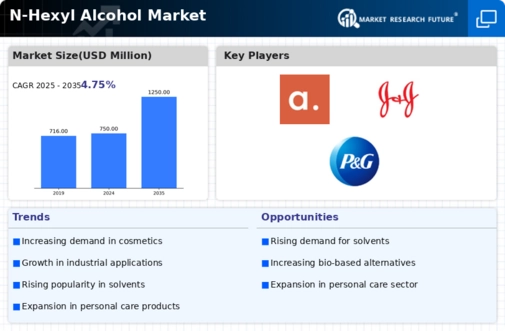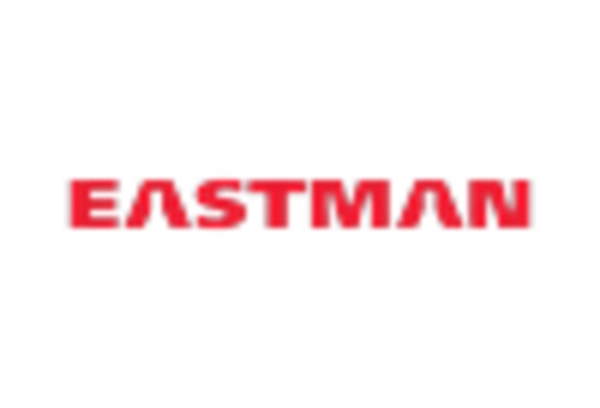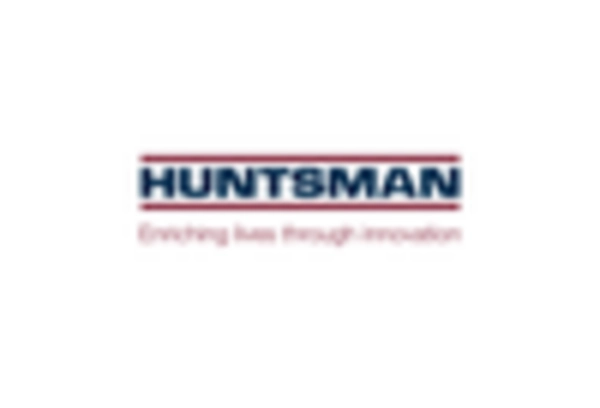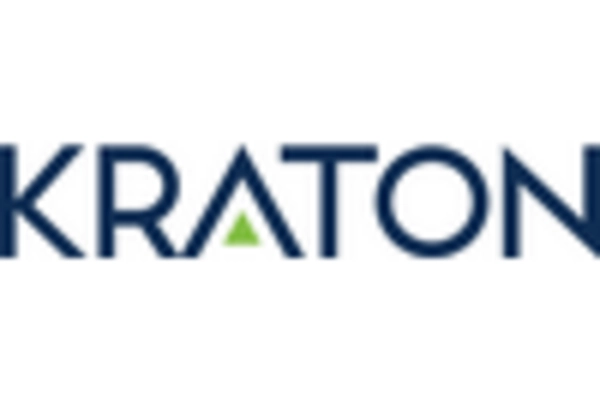-
Executive Summary
-
Scope of the Report
-
Market Definition
-
Scope of the Study
- Research Objectives
- Assumptions & Limitations
-
Markets Structure
-
Market
-
Research Methodology
-
Research Process
-
Secondary Research
-
Primary Research
-
Forecast Model
-
Market Landscape
-
Five Forces Analysis
-
of Buyers
-
Value Chain/Supply Chain of Global N-Hexyl Alcohol Market
-
Threat of New Entrants
-
Bargaining power
-
Threat of Substitutes
-
Segment Rivalry
-
Industry Overview
-
of Global N-Hexyl Alcohol Market
-
Introduction
-
Growth Drivers
-
Impact Analysis
-
Market Challenges
-
Market Trends
-
Introduction
-
Growth Trends
-
Impact Analysis
-
Global
-
N-Hexyl Alcohol Market, by Application
-
Introduction
-
Plasticizer
- Market Estimates & Forecast, 2020–2027
-
Precursor
-
Market Estimates & Forecast, by Region, 2020–2027
-
Chemical Intermediate
- Market Estimates & Forecast, 2020–2027
- Market Estimates
-
& Forecast, by Region, 2020–2027
-
Odor Agent
- Market
- Market Estimates & Forecast,
-
Estimates & Forecast, 2020–2027
-
by Region, 2020–2027
-
Flavoring Agent
- Market Estimates
- Market Estimates & Forecast, by Region,
-
& Forecast, 2020–2027
-
Inert Ingredient
- Market Estimates & Forecast,
- Market Estimates & Forecast, by Region, 2020–2027
-
Lubricant
- Market Estimates & Forecast, 2020–2027
-
Market Estimates & Forecast, by Region, 2020–2027
-
Additive
- Market Estimates & Forecast, 2020–2027
- Market Estimates
- Food
- Lubricant
- Fuel
-
& Forecast, by Region, 2020–2027
-
& Forecast, 2020–2027
-
Region, 2020–2027
-
Forecast, 2020–2027
-
Processing
- Market Estimates & Forecast, 2020–2027
- Market
-
Aid
-
Estimates & Forecast, by Region, 2020–2027
-
Fabric Softener
- Market Estimates & Forecast, 2020–2027
- Market Estimates
-
& Forecast, by Region, 2020–2027
-
Others
- Market Estimates
- Market Estimates & Forecast, by
-
& Forecast, 2020–2027
-
Region, 2020–2027
-
Global N-Hexyl Alcohol Market, by End-Use Industry
-
Introduction
-
Chemicals
- Market Estimates & Forecast,
- Market Estimates & Forecast, by Region, 2020–2027
-
Food & Beverage
- Market Estimates & Forecast, 2020–2027
- Market Estimates & Forecast, by Region, 2020–2027
-
Cosmetics
- Market Estimates & Forecast, 2020–2027
- Market Estimates & Forecast, by Region, 2020–2027
-
& Personal Care
-
Pharmaceuticals
- Market Estimates & Forecast, 2020–2027
- Market Estimates
-
& Forecast, by Region, 2020–2027
-
Textiles
- Market Estimates
- Market Estimates & Forecast, by Region,
-
& Forecast, 2020–2027
-
Plastic
- Market Estimates & Forecast, 2020–2027
- Market Estimates & Forecast, by Region, 2020–2027
-
Others
- Market Estimates & Forecast, 2020–2027
- Market Estimates
-
& Forecast, by Region, 2020–2027
-
Global N-Hexyl Alcohol Market,
-
by Region
-
Introduction
-
North America
- Market Estimates
- Market Estimates & Forecast, by Application,
- Market Estimates & Forecast, by End-Use Industry,
- US
-
& Forecast, 2020–2027
-
Market Estimates & Forecast, by End-Use Industry, 2020–2027
-
Canada
-
Market Estimates & Forecast, 2020–2027
-
Market Estimates & Forecast, by Application, 2020–2027
-
Estimates & Forecast, by End-Use Industry, 2020–2027
-
& Forecast, by Application, 2020–2027
-
Forecast, by End-Use Industry, 2020–2027
-
Estimates & Forecast, 2020–2027
-
by Application, 2020–2027
-
End-Use Industry, 2020–2027
-
& Forecast, 2020–2027
-
Application, 2020–2027
-
Industry, 2020–2027
-
Market
-
Europe
- Market Estimates & Forecast, 2020–2027
- Market Estimates
- Market Estimates &
- Germany
- France
- Italy
- Spain
-
Market Estimates & Forecast, by Application, 2020–2027
-
Estimates & Forecast, by End-Use Industry, 2020–2027
-
& Forecast, by Application, 2020–2027
-
Forecast, by End-Use Industry, 2020–2027
-
Estimates & Forecast, 2020–2027
-
by Application, 2020–2027
-
End-Use Industry, 2020–2027
-
& Forecast, 2020–2027
-
Application, 2020–2027
-
Industry, 2020–2027
-
Forecast, 2020–2027
-
Market
-
UK
-
Market Estimates & Forecast, 2020–2027
-
Market Estimates
-
Market Estimates &
-
Russia
-
Market
-
Market Estimates & Forecast,
-
Market Estimates & Forecast, by
-
Poland
-
Market Estimates
-
Market Estimates & Forecast, by
-
Market Estimates & Forecast, by End-Use
-
Asia-Pacific
- Market Estimates &
- Market Estimates & Forecast, by Application,
- Market Estimates & Forecast, by End-Use Industry,
- China
-
Market Estimates & Forecast, by End-Use Industry, 2020–2027
-
India
-
Market Estimates & Forecast, 2020–2027
-
Market Estimates & Forecast, by Application, 2020–2027
-
Estimates & Forecast, by End-Use Industry, 2020–2027
-
& Forecast, by Application, 2020–2027
-
Forecast, by End-Use Industry, 2020–2027
-
Market Estimates & Forecast, 2020–2027
-
Forecast, by Application, 2020–2027
-
by End-Use Industry, 2020–2027
-
Estimates & Forecast, 2020–2027
-
by Application, 2020–2027
-
End-Use Industry, 2020–2027
-
Estimates & Forecast, 2020–2027
-
by Application, 2020–2027
-
End-Use Industry, 2020–2027
-
Market Estimates & Forecast, 2020–2027
-
Forecast, by Application, 2020–2027
-
by End-Use Industry, 2020–2027
-
& Forecast, 2020–2027
-
Application, 2020–2027
-
Industry, 2020–2027
-
Forecast, 2020–2027
-
Market
-
Japan
-
Market Estimates & Forecast, 2020–2027
-
Market Estimates
-
Market Estimates &
-
Australia
-
Market Estimates &
-
Market Estimates & Forecast,
-
New Zealand
-
Market
-
Market Estimates & Forecast,
-
Market Estimates & Forecast, by
-
Rest of Asia-Pacific
-
Market
-
Market Estimates & Forecast,
-
Market Estimates & Forecast, by
-
Middle East & Africa
- Market Estimates &
- Market Estimates & Forecast,
- Turkey
- Israel
- North Africa
- GCC
-
Market Estimates & Forecast, by Application, 2020–2027
-
Estimates & Forecast, by End-Use Industry, 2020–2027
-
the Middle East & Africa
-
Market
-
Rest of
-
Market Estimates & Forecast, 2020–2027
-
Market Estimates & Forecast, by Application, 2020–2027
-
Market Estimates & Forecast, by End-Use Industry, 2020–2027
-
Latin
- Market Estimates & Forecast, 2020–2027
- Market
- Market Estimates
- Brazil
- Argentina
- Mexico
- Rest of Latin America
-
America
-
Estimates & Forecast, by Application, 2020–2027
-
& Forecast, by End-Use Industry, 2020–2027
-
Market Estimates & Forecast, 2020–2027
-
Forecast, by Application, 2020–2027
-
by End-Use Industry, 2020–2027
-
& Forecast, 2020–2027
-
Application, 2020–2027
-
Industry, 2020–2027
-
Forecast, 2020–2027
-
& Forecast, 2020–2027
-
Application, 2020–2027
-
Industry, 2020–2027
-
Company Landscape
-
Company Profiles
-
Sasol Limited
- Company Overview
- Application/Business
- Financial Updates
- Key Developments
- Company Overview
- Application/Business Segment
- Financial Updates
- Key Developments
-
Segment Overview
-
Alfa Aesar
-
Overview
-
The
- Company Overview
- Application/Business
- Financial Updates
- Key Developments
- Company Overview
- Application/Business Segment
- Financial Updates
- Key Developments
-
Good Scents Company
-
Segment Overview
-
Merck KGaA
-
Overview
-
Bharat
- Company Overview
- Application/Business Segment
- Financial Updates
- Key Developments
-
Jyoti Impex
-
Overview
-
Penta
- Company Overview
- Application/Business Segment
- Financial Updates
- Key Developments
-
Manufacturer
-
Overview
-
Sisco
- Company Overview
- Application/Business
- Financial Updates
- Key Developments
- Company Overview
- Application/Business
- Financial Updates
- Key Developments
- Company Overview
- Application/Business
- Financial Updates
- Key Developments
- Company Overview
- Application/Business
- Financial Updates
- Key Developments
-
Research Laboratories Pvt. Ltd.
-
Segment Overview
-
Ecogreen Oleochemicals
-
Segment Overview
-
Zhejiang NHU Company Ltd, NHU
-
Segment Overview
-
Haihang Industry Company
-
Segment Overview
-
Yancheng Hongtai Bioengineering Co., Ltd.
- Company Overview
- Application/Business Segment Overview
- Financial Updates
- Key Developments
-
Conclusion
-
LIST OF TABLES
-
Table 1
-
World Population in Major Regions (2020–2030)
-
Global N-Hexyl
-
Alcohol Market, by Region, 2020–2027
-
North America: N-Hexyl Alcohol
-
Market, by Country, 2020–2027
-
Europe: N-Hexyl Alcohol Market,
-
by Country, 2020–2027
-
Asia-Pacific: N-Hexyl Alcohol Market, by
-
Country, 2020–2027
-
Middle East & Africa: N-Hexyl Alcohol
-
Market, by Country, 2020–2027
-
Latin America: N-Hexyl Alcohol
-
Market, by Country, 2020–2027
-
Global N-Hexyl Alcohol Application
-
Market, by Region, 2020–2027
-
North America: N-Hexyl Alcohol Application
-
Market, by Country, 2020–2027
-
Europe: N-Hexyl Alcohol Application
-
Market, by Country, 2020–2027
-
Table11 Asia-Pacific: N-Hexyl Alcohol Application
-
Market, by Country, 2020–2027
-
Table13 Middle East & Africa: N-Hexyl
-
Alcohol Application Market, by Country, 2020–2027
-
Table12 Latin America:
-
N-Hexyl Alcohol Application Market, by Country, 2020–2027
-
Table14 North
-
America: N-Hexyl Alcohol End-Use Industry Market, by Country, 2020–2027
-
Table13 Europe: N-Hexyl Alcohol End-Use Industry Market, by Country, 2020–2027
-
Table14 Asia-Pacific: N-Hexyl Alcohol End-Use Industry Market, by Country, 2020–2027
-
Table16 Middle East & Africa: N-Hexyl Alcohol End-Use Industry Market, by
-
Country, 2020–2027
-
Table15 Latin America: N-Hexyl Alcohol End-Use Industry
-
Market, by Country, 2020–2027
-
Table23 Global Application Market, by
-
Region, 2020–2027
-
Table24 Global End-Use Industry Market, by Region,
-
Table25 North America: N-Hexyl Alcohol Market, by Country,
-
Table26 North America: N-Hexyl Alcohol Market, by Application,
-
Table27 North America: N-Hexyl Alcohol Market, by End-Use
-
Industry, 2020–2027
-
Table28 Europe: N-Hexyl Alcohol Market, by Country,
-
Table29 Europe: N-Hexyl Alcohol Market, by Application, 2020–2027
-
Table30 Europe: N-Hexyl Alcohol Market, by End-Use Industry, 2020–2027
-
Table31 Asia-Pacific: N-Hexyl Alcohol Market, by Country, 2020–2027
-
Table32 Asia-Pacific: N-Hexyl Alcohol Market, by Application, 2020–2027
-
Table33 Asia-Pacific: N-Hexyl Alcohol Market, by End-Use Industry, 2020–2027
-
Table36 Middle East & Africa: N-Hexyl Alcohol Market, by Country, 2020–2027
-
Table37 Middle East & Africa N-Hexyl Alcohol Market, by Application, 2020–2027
-
Table33 Middle East & Africa: N-Hexyl Alcohol Market, by End-Use Industry,
-
Table34 Latin America: N-Hexyl Alcohol Market, by Country,
-
Table35 Latin America N-Hexyl Alcohol Market, by Application,
-
Table33 Latin America: N-Hexyl Alcohol Market, by End-Use
-
Industry, 2020–2027
-
LIST OF FIGURES
-
Global N-Hexyl
-
Alcohol Market Segmentation
-
Forecast Methodology
-
Five
-
Forces Analysis of Global N-Hexyl Alcohol Market
-
Value Chain of Global
-
N-Hexyl Alcohol Market
-
Share of Global N-Hexyl Alcohol Market in 2020,
-
by Country (%)
-
Global N-Hexyl Alcohol Market, 2020–2027,
-
Sub-Segments of Application, 2020
-
Global N-Hexyl Alcohol
-
Market Size, by Application, 2020
-
Share of Global N-Hexyl Alcohol
-
Market, by Application, 2020–2027
-
Sub-Segments of End-Use Industry
-
Global N-Hexyl Alcohol Market Size, by End-Use Industry, 2020
-
FIGURE
-
Share of Global N-Hexyl Alcohol Market, by End-Use Industry, 2020–2027

















Leave a Comment